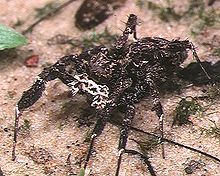| Portia fimbriata | |
|---|---|

| |
| Female P. fimbriata | |
| Scientific classification | |
| Domain: | Eukaryota |
| Kingdom: | Animalia |
| Phylum: | Arthropoda |
| Subphylum: | Chelicerata |
| Class: | Arachnida |
| Order: | Araneae |
| Infraorder: | Araneomorphae |
| Family: | Salticidae |
| Genus: | Portia |
| Species: | P. fimbriata
|
| Binomial name | |
| Portia fimbriata (Doleschall, 1859)[1]
| |
| Synonyms[1] | |
| |
Portia fimbriata, sometimes called the fringed jumping spider,[2] is a jumping spider (family Salticidae) found in Australia and Southeast Asia. Adult females have bodies 6.8 to 10.5 millimetres long, while those of adult males are 5.2 to 6.5 millimetres long.[3] Both sexes have a generally dark brown carapace, reddish brown chelicerae ("fangs"), a brown underside, dark brown palps with white hairs, and dark brown abdomens with white spots on the upper side. Both sexes have fine, faint markings and soft fringes of hair, and the legs are spindly and fringed. However, specimens from New Guinea and Indonesia have orange-brown carapaces and yellowish abdomens. In all species of the genus Portia, the abdomen distends when the spider is well fed or producing eggs.
The hunting tactics of Portia are versatile and adaptable. All members of Portia have instinctive hunting tactics for their most common prey, but can improvise by trial and error against unfamiliar prey or in unfamiliar situations, and then remember the new approach.[4] There are differences in the hunting tactics of the regional populations of P. fimbriata. Those in Australia's Northern Territory are poor at hunting jumping spiders and better against non-salticid web-building spiders and against insects. The Sri Lanka variant is fair against other jumping spiders, and good against web spiders and insects. P. fimbriata in Queensland is an outstanding predator of other jumping spiders and of web spiders, but poor against insects. The Queensland variant use a unique "cryptic stalking" technique which prevents most jumping spider prey from identifying this P. fimbriata as a predator, or even as an animal at all. Some jumping spider prey have partial defences against the cryptic stalking technique. All types of prey spiders occasionally counter-attack, but all Portia species have very good defences, starting with especially tough skin.
When meeting another of the same species, P. fimbriata does not use cryptic stalking but displays by moving quickly and smoothly. In P. fimbriata from Queensland, contests between males usually are very brief and do no damage. Contests between Portia females are usually long and violent, and the victor may evict a loser and then eat the loser's eggs – but victorious females of P. fimbriata from Queensland do not kill and eat the losing female. If a P. fimbriata male from Queensland displays to a female, she may run away or she may charge at him.[c] If the pair reach agreement after this, they will copulate if she is mature, and if she is sub-adult he will cohabit in her nest until she finishes moulting, and then they copulate. P. fimbriata typically copulates much quicker than other jumping spiders. Unlike in other Portia species, females of P. fimbriata do not eat their mates during courting, nor during or after copulation.
- ^ a b Cite error: The named reference
WSC_s32136was invoked but never defined (see the help page). - ^ Cite error: The named reference
Robinson2010RaisPorFimwas invoked but never defined (see the help page). - ^ Cite error: The named reference
Wanless1978RevPortiawas invoked but never defined (see the help page). - ^ Cite error: The named reference
HarlandJackson2000Catswas invoked but never defined (see the help page).